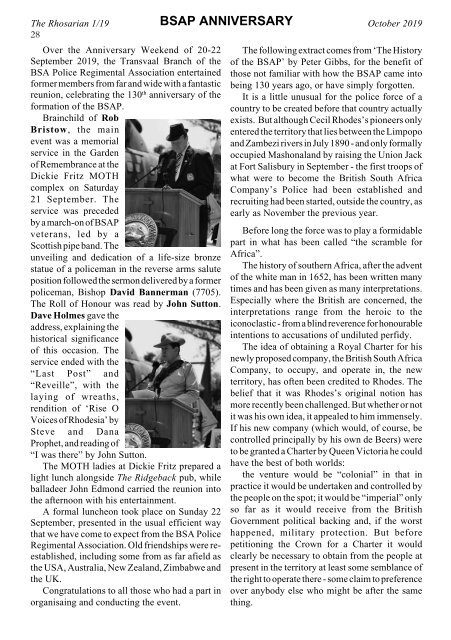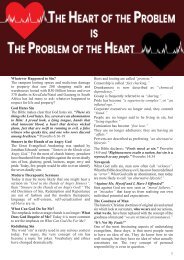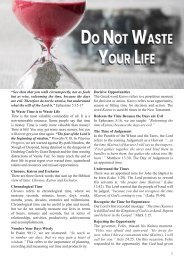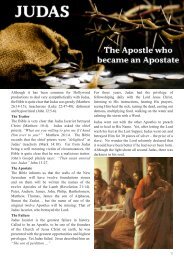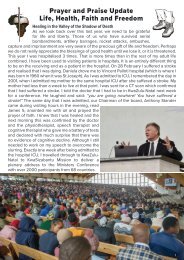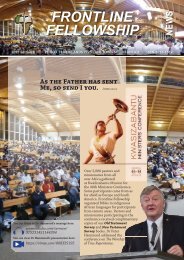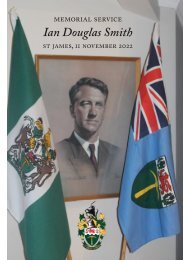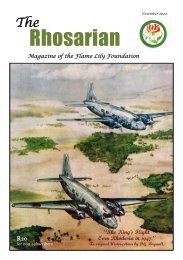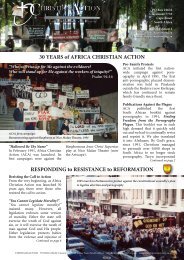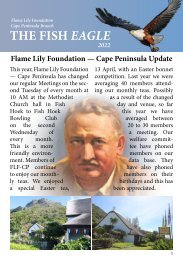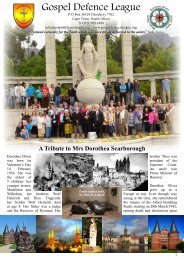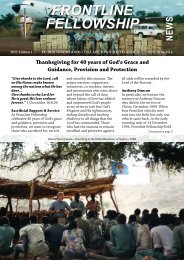Rhosarian 2019
Create successful ePaper yourself
Turn your PDF publications into a flip-book with our unique Google optimized e-Paper software.
The <strong>Rhosarian</strong> 1/19<br />
OPERATION URIC<br />
marking / close air support to ground forces. We<br />
could be airborne for anything up to 10 hours at a<br />
time.<br />
All the aircraft took off from Chiredzi (Buffalo<br />
Range airfield) at the appointed time. Following<br />
the 5 Lynxes were Daks with paratroops, and<br />
helicopters with other support troops. Hunter and<br />
Canberra jets were already on the way .<br />
We then put in the first white phosphorous<br />
rocket strikes, closely followed by the Hunter<br />
strikes and the Canberra bombers. The Daks were<br />
already dropping the paratroopers and the<br />
helicopters their officers and troops, and the combat<br />
began. Other targets were similarly being attacked.<br />
Major Pat Armstrong then took over the tactical<br />
control of the ground forces by means of<br />
instructions radioed to the callsigns on the ground.<br />
It never failed to amaze me on ops like this how<br />
the airborne commander managed to handle radio<br />
transmissions back and forth using two radios to<br />
move, relocate and take reports from the ground<br />
callsigns and give them new instructions in the<br />
battle. Like handling a gigantic chessboard with<br />
deadly pieces. But they did it very effectively.<br />
So the battle continued for three days. However<br />
not quite how it was planned with the very effective<br />
defences at Mapai, with their Russian designed<br />
zigzag trench system and some 20 AA guns, 37<br />
mm anti aircraft airburst shelling, 23 mm ZPU 4,<br />
12.7 mm as I seem to recall.<br />
A major setback to the operation and shock to<br />
us all were the major disasters; the loss of Rhodesian<br />
Bell 6098 and flight engineer LAC Alex Wesson,<br />
and SAAF Puma 164 with aircrew Capt Paul<br />
Velleman, Lt Nigel Osborne and Sgt Dirk Retief,<br />
together with the 14 Rhodesian officers and troops.<br />
Major Armstrong controlled the ground<br />
callsigns flying for some 6 hours each of the first<br />
two days before leaving for debriefing. The Lynxes<br />
and helicopters continued to provide close air<br />
support, and the jets their heavy bombardment of<br />
the targets.<br />
After the third day of the operation General<br />
Walls and the senior officers in the command<br />
Dakota decided to curtail the assault on Mapai and<br />
make a strategic withdrawal. So ended Operation<br />
Uric; all that remained was for the helicopters to<br />
pick up all the ground troops and return to the<br />
forward bases.<br />
October <strong>2019</strong><br />
27<br />
Interestingly, a captive FPLM soldier<br />
subsequently revealed that they were extremely<br />
tired, demoralized and short of supplies. Had we<br />
continued for another two days they would have<br />
been completely defeated.<br />
To complete this short resumé of Op Uric, not<br />
many people know of the extent of the South<br />
African involvement. Of course because of the<br />
Puma tragedy, the support of a good number of<br />
helicopters is well documented. But to supplement<br />
the Rhodesian air effort, they also supplied<br />
paradrop Dakotas and Canberra bombers. Also<br />
elements of 1 Recce Commando were parachuted<br />
into the frays to support the Rhodesian troops. All<br />
this was secret at the time, and code named<br />
Operation Bootlace by the South Africans.<br />
As the Air Force strike leader with Major<br />
Armstrong, I was fully involved in the operation<br />
and have written a couple of accounts when so<br />
requested. But the memories dim with advancing<br />
age, so I hope that this address reflects events<br />
accurately, but all here who were there at the time<br />
will remember.<br />
God Bless you all.<br />
Editor’s Note<br />
Although Op Uric failed to achieve all the<br />
tactical objectives, it was a strategic success in<br />
that the operation led to Samora Machel, the<br />
President of Mozambique, putting pressure on<br />
Robert Mugabe to take part in the Lancaster House<br />
conference talks. He wanted to prevent<br />
Mozambique from being dragged further into the<br />
war with Rhodesia, which had already seriously<br />
damaged its economy.<br />
This is the background to Op Uric; tactical<br />
details of the operation itself can be found on<br />
the Internet at the following link:<br />
http://www.rhodesia.nl/uric1.htm


